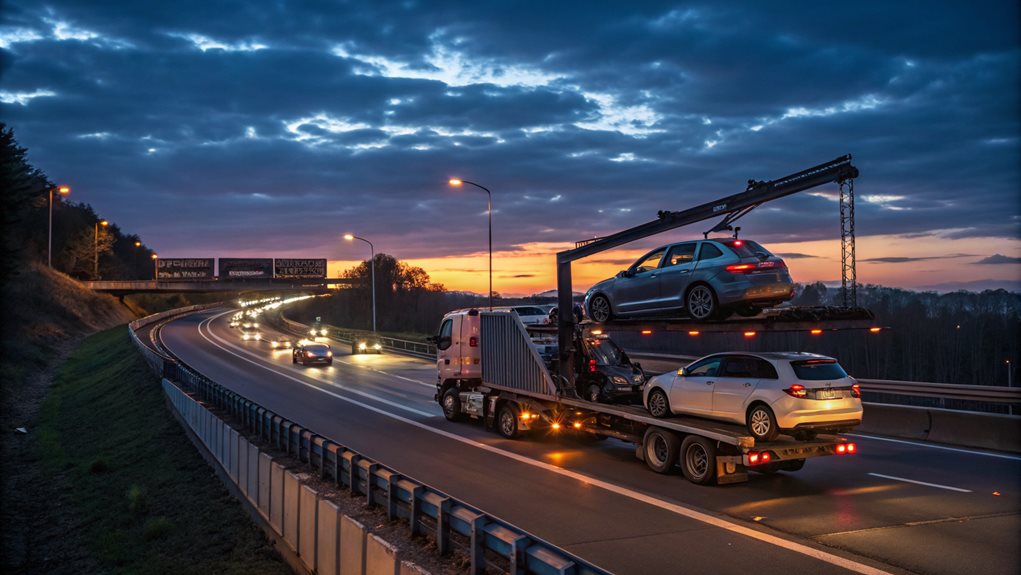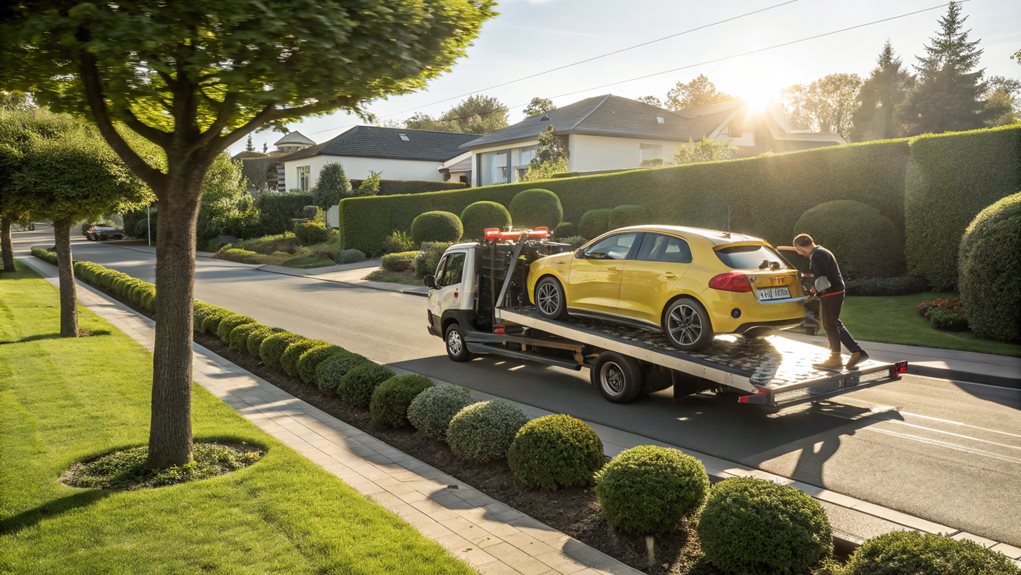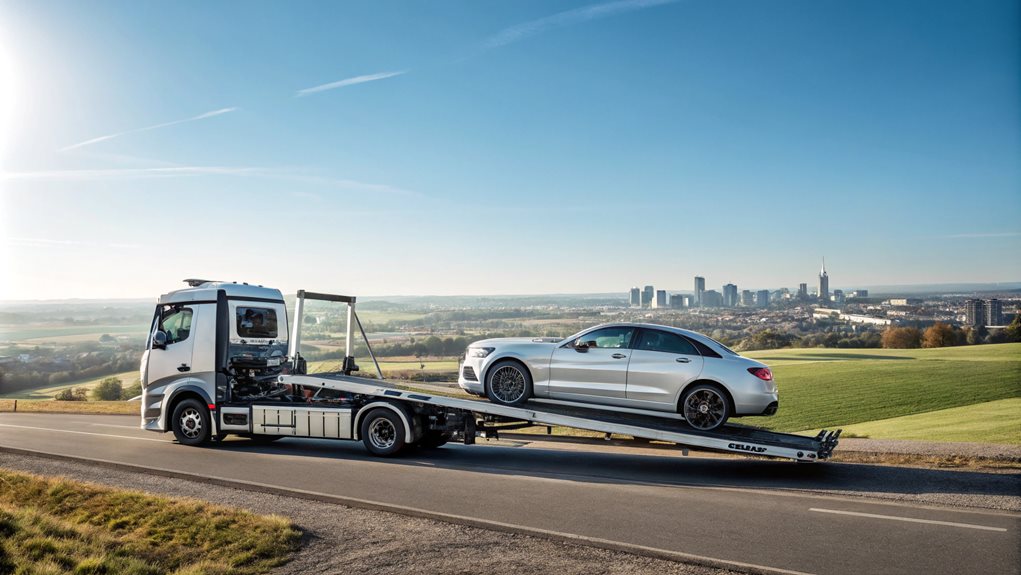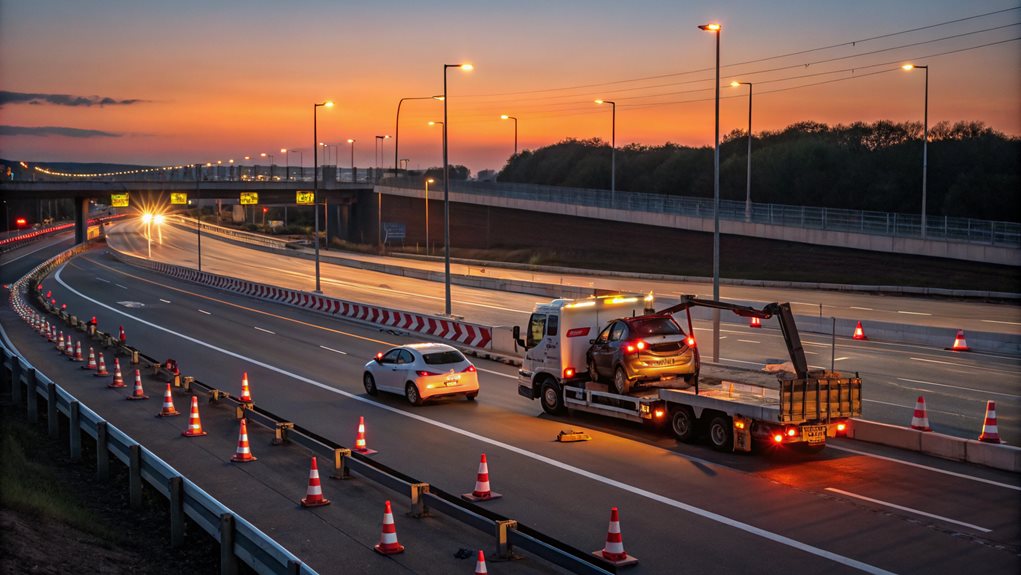Understanding the intricacies of towing services is indispensable for effective vehicle mishap management. The industry offers a wide array of solutions, including emergency towing that guarantees safety and swift assistance at any time. Light towing necessary for passenger and small truck recovery utilizes hydraulic systems for secure transport, while heavier scenarios call for heavy-duty towing adhering to strict safety regulations, often with escort vehicles for oversized loads. Specialized recovery equipment is adept at handling difficult terrains, emphasizing safety with advanced winch technology and operator expertise. These tailored approaches promise proficient solutions, revealing more about the capabilities within this fundamental service sector.
Expert Highlights
- Emergency towing services are available 24/7, offering assistance in various terrains and handling all vehicle types safely.
- Vehicle recovery utilizes winches and recovery straps, focusing on safety and operability in challenging locations.
- Specialized recovery equipment includes flatbed, wheel-lift, and heavy-duty tow trucks, ensuring efficient and safe procedures.
- Light towing accommodates passenger vehicles, motorcycles, and small trucks, often using flatbed or wheel-lift techniques.
- Heavy-duty towing handles loads up to 75 tons, eliminating risks and complying with safety regulations and state permits.
Emergency Towing Services

Emergency towing services serve as a lifeline for drivers facing unexpected vehicle mishaps, offering prompt assistance around the clock. These services are indispensable, guaranteeing immediate response in emergencies such as accidents or sudden breakdowns, particularly in high-traffic areas. By prioritizing safety, they provide swift vehicle removal, mitigating potential hazards.
With extensive coverage capabilities, emergency towing services operate efficiently across diverse terrains, including highways and remote areas. Handling all vehicle types, from motorcycles to heavy-duty trucks, these services employ specialized equipment, including winches and flatbed trucks for luxury vehicles. In addition to their versatility, emergency towing can include long-distance towing for comprehensive vehicle transport over greater distances. Flatbed towing is ideal for vehicles with low clearance or those that are all-wheel drive, preventing wheels from touching the ground during transport. Technicians are professionally trained, using modern tools to offer reliable assistance, while customer-focused support ensures a sense of belonging, reassuring drivers that help is readily available in their moment of need. Service providers in Minneapolis and St. Paul offer 24/7 availability, making sure drivers can access emergency roadside help when needed.
Vehicle Recovery Techniques
In the domain of vehicle recovery techniques, specialized equipment like winches, kinetic and static recovery straps, and snatch blocks play a critical role in ensuring successful retrieval operations in challenging situations. Using the correct address or location is essential for emergency situation roadside help, as prompt assistance can be crucial. Proper maintenance, such as applying pre-tension to the cable, is crucial for ensuring reliable winch performance. With over 70% of drivers having experienced at least one recovery incident, being prepared with the right knowledge and tools is essential. When faced with overturned vehicles or those trapped in precarious locations, understanding the proper application of these tools alongside innovative strategies—such as using traction boards and carefully assessed anchor points—becomes indispensable.
Specialized Recovery Equipment
Specialized recovery equipment plays an essential role in ensuring the safe and efficient retrieval of vehicles from challenging situations. Key to such operations are specialized recovery trucks, including flatbed tow trucks and wheel-lift variants, which are adept at handling everything from compact cars to substantial construction machinery. Winch trucks are indispensable for extricating vehicles from difficult terrains, while heavy-duty tow trucks boast robust features for managing larger loads. Recovery truck operations are managed by highly trained professionals who execute safe and efficient towing procedures, playing a vital role in emergencies. Complementary tools like winches, lifting jacks, and safety chains further enhance recovery efforts, providing stability and security. Equipment like integrated tow trucks, with their auxiliary systems, offer versatility essential for varied recovery scenarios. Specialty gear, including motorcycle cradles and RV towing adaptations, underscores the commitment to tailored solutions in diverse recovery challenges.
Overturned Vehicle Strategies
Building upon the capabilities provided by specialized recovery equipment, addressing overturned vehicles presents a unique set of challenges that require precise techniques to guarantee both safety and efficiency.
The stabilization of such vehicles is essential before initiating any recovery operation. Utilizing stabilizing jacks or cribbing, professionals make certain that the vehicle remains stationary. Close assessment of weight distribution guides the appropriate method employed, while a firm, level ground minimizes further instability. Wheel chocks are applied on inclines for added security.
Safety is paramount, encompassing protective gear and verifying recovery equipment's integrity. The use of kinetic energy recovery straps or winching techniques further aids in vehicle realignment, all before meticulously inspecting for damage to affirm vehicle operability and document procedural insights.
Challenging Location Solutions
Addressing vehicle recovery scenarios in challenging locations necessitates tailored techniques to overcome distinct obstacles presented by diverse environments. In urban settings, coordination with local authorities is vital for traffic management, while adhering to regulatory compliance guarantees seamless operations. Specialized recovery vehicles adept at traversing tight spaces, coupled with GPS and AI-driven technologies, enhance efficiency amidst space constraints.
Conversely, rural recoveries demand off-road equipment and solutions to tackle diverse terrains, such as utilizing winches and recovery boards. Local knowledge and strategic anchor points are priceless for maneuvering rugged landscapes. Implementing extensive safety protocols across both scenarios, including stability assessments and environmental protection measures, underscores the importance of meticulous preparation. Professional training ensures operators are well-equipped to handle varied recovery challenges.
Light Towing Essentials

Often called upon for their versatility and efficacy, light towing services are fundamental to transporting various types of vehicles, especially in everyday circumstances. These services address the paramount needs of those owning passenger vehicles, motorcycles, and small trucks, accommodating up to 10,000 lbs. Utilizing methods such as flatbed towing for luxury vehicles or wheel-lift techniques, guarantees ample safety and maneuverability. The inclusion of equipment like hydraulic winches and cable systems enhances operational proficiency, safeguarding the vehicle and parties involved. Opting for a credible, licensed towing provider is indispensable, preventing potential mishaps. Aligning with professional and experienced drivers ensures secure and safe transport of the vehicle to its destination.
| Vehicle Type | Towing Method | Safety Considerations |
|---|---|---|
| Passenger Vehicles | Flatbed/Wheel-lift | Proper Securing Needed |
| Motorcycles | Flatbed or Dolly | Secure Straps Required |
| Small Trucks | Cable and Winch | Condition Documentation |
| Boats/Trailers | Flatbed/Dolly | Weight Limit Awareness |
| Abandoned Vehicles| Hydraulic Winch | Use Licensed Providers
Heavy-Duty Towing Needs
When dealing with the complexities of heavy-duty towing needs, it is paramount to understand the particular requirements of vehicles such as semi-trucks, buses, and even fire trucks. These vehicles require specialized equipment, including powerful winches and hydraulic systems, to guarantee safe transportation. The expertise of skilled operators is crucial as they adeptly maneuver and secure loads potentially reaching 75 tons. The operation demands compliance with strict safety protocols and state regulations, which often necessitate the use of escort vehicles for oversized cargo. Service providers, like Doug Yates Towing & Recovery, emphasize 24/7 availability and extensive fleet capabilities to accommodate and streamline large-scale towing processes. Possessing annual multi-state permits allows for expedited transport, reinforcing their commitment to seamless, heavy-duty towing services. Additionally, 24-hour roadside assistance coverage in Minnesota ensures reliable emergency response and comprehensive services are available even in unexpected situations.
Flatbed Towing Advantages

Maneuvering the intricacies of towing, particularly with heavy-duty vehicles, underscores the value of versatile solutions like flatbed towing. It offers significant safety advantages by completely eliminating the risk of damaging tires, suspension, or transmission, and guarantees the vehicle remains secure on a stable platform, which minimizes vulnerability to road debris. Convenient loading with hydraulic lifts requires no elaborate configurations, consequently expediting the process and reducing roadside exposure and potential traffic interruptions. Flatbed towing's adaptability allows it to accommodate a wide range, from luxury vehicles to construction equipment, supporting both personal and commercial needs. Its cost-effectiveness further enhances appeal by preventing additional damage and minimizing environmental impact, offering an eco-friendly and financially prudent choice for vehicle transport. Remember, employing professional roadside assistance services ensures trained technicians handle these procedures safely, enhancing overall security and preventing further damage.
Wheel Lift Towing Basics
In discussing the fundamentals of wheel lift towing, it is essential to recognize its effective hook-up method, which involves securely attaching a metal yoke to the vehicle's front or rear wheels for transportation. This towing technique is particularly suitable for vehicles that are still driveable and can be conveniently moved over short distances, offering a cost-effective alternative to other methods. Wheel lift towing not only provides a time-saving solution due to its quick loading process but also minimizes risk to the vehicle's structural components, making it an ideal choice for maneuvering dense urban environments. Additionally, wheel lift towing is a practical option in areas like Dinkytown MN, where dense student life and narrow streets require efficient transportation solutions.
Effective Hook-Up Method
An essential aspect of wheel lift towing is the effective hook-up method, which guarantees both the safety and efficiency of the towing process. This method begins with precise tow truck placement, ensuring ample clearance for the operator to control the lift.
The vehicle is then secured using wheel straps or hooks attached to either the front or rear wheels, contingent upon the vehicle's transmission type. With the vehicle in neutral, the operator activates the hydraulic system from the tow truck's cab, raising the vehicle's wheels.
Prioritizing stability, the operator vigilantly observes the lift to confirm that the vehicle is securely balanced throughout transport. Components such as the metal yoke and hydraulic bars work in harmony, enhancing efficiency while minimizing damage to the vehicle's drivetrain and suspension.
Suitable Vehicle Types
When considering the appropriate towing method for vehicle recovery, wheel lift towing emerges as a viable option for many situations. This method is particularly compatible with driveable vehicles such as small to midsize cars, sedans, SUVs, and pickup trucks, where the use of a metal yoke to lift the front or rear wheels proves both efficient and manageable.
The wheel lift towing mechanism, driven by a hydraulic or pneumatic system, leaves the opposite wheels on the ground, reducing strain and minimizing the risk of drivetrain damage compared to traditional hook and chain towing. This approach offers a versatile hauling solution, making it ideal for roadside assistance, accident recovery, and impounding operations, whilst ensuring safety and protection for fragile vehicles needing repair.
Cost-Effective Solutions
Several factors contribute to the appeal of wheel lift towing as a cost-effective solution within the towing industry. Foremost, these trucks carry considerably lower purchase and maintenance costs compared to full-sized alternatives, given their compact design and reduced fuel requirements.
This efficiency extends to their operation; wheel lift systems provide quick and seamless loading, particularly advantageous in congested urban environments. The simplicity of automated hydraulic controls bolsters this, ensuring ease of use while minimizing labor, consequently enhancing overall operational effectiveness.
Additionally, cost savings are amplified by their installation on pickup models, allowing for adjustable configurations without extensive expense. Collectively, these attributes underscore the financial prudence of adopting wheel lift systems, fostering a sense of belonging to a community that values economic efficiency and modernity.
Specialized Equipment Usage

Understanding the variety of specialized equipment used in towing services is essential for determining the most appropriate method for safely transporting vehicles. Different towing scenarios necessitate diverse approaches, each tailored to specific vehicle needs.
For luxury cars and damaged vehicles, flatbed towing is preferred due to its safety and reliability, involving a hydraulically operated bed.
- Flatbed Towing: Safely lifts all wheels off the ground, ideal for luxury and damaged vehicles.
- Wheel Lift Towing: Employs a metal yoke for quick positioning under drive wheels, suitable for non-all-wheel drive vehicles.
- Heavy-Duty Towing: Uses powerful wreckers and rotators for lifting and moving large trucks and equipment.
- Integrated Towing: Designed for heavy-duty vehicles like buses and RVs, offers stability with extra axles.
- Hook and Chain Towing: Traditional method, now avoided for potential damage to vehicles.
Rapid Response Strategies
Amidst the urgency of emergency scenarios, rapid response strategies are integral to effective towing services. In accidents or vehicle breakdowns, particularly within high-traffic or hazardous locations, towing teams must act swiftly to prevent congestion and maintain safety.
A 24/7 operational framework, supported by advanced dispatch systems, enables prompt location of available tow trucks and enhances response times. Effective communication with customers and synchronized team coordination guarantee the deployment of appropriate resources swiftly.
Quick situational assessments dictate the required equipment, while thorough vehicle stability checks and equipment readiness secure smooth operations. Additionally, real-time updates foster transparency, addressing customer concerns promptly.
Employing ideal routes and traffic considerations further facilitates expedient service, providing a lifeline in time-sensitive scenarios.
Safety Measures in Towing

Guaranteeing safety in towing operations is paramount, requiring meticulous attention to vehicle maintenance and rigorous adherence to safe towing practices. Professionals in the towing industry must prioritize regular inspection and upkeep to guarantee all mechanical components and towing equipment are in ideal condition.
Following are critical safety measures essential for reliable towing services:
- Regularly inspect tow trucks and equipment to prevent malfunctions.
- Calculate towing capacity accurately and never exceed limits.
- Secure towed vehicles properly with straps and chains.
- Adhere to defensive driving techniques for road safety.
- Equip personnel with necessary personal protective equipment (PPE).
Such practices not only safeguard towing personnel but also foster a sense of community reliability and support. By upholding these standards, towing professionals strengthen trust and guarantee efficient, secure operations for all involved.
Industry Applications
Effective towing operations extend beyond safety measures, highlighting diverse industry applications that cater to a wide array of vehicle types and towing needs. The automotive industry benefits greatly from various methods like flatbed and wheel lift towing, effectively serving car transport requirements. Heavy-duty and integrated towing services are indispensable in the construction industry, facilitating the movement of substantial machinery and equipment. Meanwhile, specialized transportation caters to off-road vehicles requiring recovery, as well as unique loads such as boats and mobile homes. For commercial applications, towing services cover large vehicles including buses and RVs, while niche services guarantee the safe transit of luxury and classic vehicles, utilizing equipment that prevents potential damage.
| Vehicle Type | Towing Need | Method or Service |
|---|---|---|
| Light Vehicles | Car transport | Flatbed, Wheel Lift |
| Heavy Vehicles | Construction equipment | Heavy-Duty, Integrated Towing |
| Luxury and Classic | Damage prevention | Flatbed Towing |
| Motorcycles | Specialized requirements | Motorcycle Towing |
| Off-Road Vehicles | Recovery | Off-road Recovery Services |
Roadside Assistance FAQ
What Are the Typical Costs Associated With Different Towing Services?
Towing service costs vary based on type and complexity: emergency towing ranges $50-$150; light towing $50-$100; heavy-duty $200-$500; integrated up to $1,000; flatbed $100-$300; wheel lift $50-$150; specialized up to $500; long-distance $200-$1,000.
Can Towing Services Be Scheduled in Advance for Planned Vehicle Relocations?
Yes, towing services can be scheduled in advance for planned vehicle relocations. This guarantees a seamless experience, allowing clients to select preferred dates and times, reinforcing the service provider's commitment to reliability and customer satisfaction.
How Do Towing Companies Handle Damaged Vehicle Property Claims?
Towing companies manage damaged vehicle property claims by collaborating closely with insurance providers, ensuring thorough documentation and assessment reports are submitted promptly. Staff are trained in claims processing, maintaining clear communication with vehicle owners to facilitate a smooth resolution.
Are There Any Towing Services Available for Motorcycles or Scooters?
Yes, specialized towing services for motorcycles and scooters are available. These services employ trained operators and use equipment like flatbed trailers and specific securing methods to guarantee safe, damage-free transport, typically offering 24/7 emergency and roadside assistance.
What Licensing and Certifications Should Reputable Towing Companies Possess?
Reputable towing companies should possess a business license, appropriate commercial driver's licenses, towing and motor carrier permits, and certifications for light, medium, or heavy-duty towing. Insurance coverage, including general liability and workers' compensation, is also essential.
